Shift work is common in many sectors. How these shifts are organised differs from one company to the next. There are a number of commonly used shift schedules, but there are many variations. This can make it quite difficult to see the wood for the trees. How can you create a shift schedule that is right for your organisation? And how do you fit your employees into that schedule? This is explained in the following article.
In this article:
1. What is a shift schedule?
2. 2-shift schedule
3. 3-shift schedule
4. 4-shift schedule
5. 5-shift schedule
6. Schedule with 6 or more shifts
7. Advantages of working in shifts
8. Working Hours Act
9. Shift scheduling made easy with Dyflexis
What is a shift schedule?
A shift schedule is a schedule consisting of multiple shifts. In many cases, it concerns an early shift, a late shift, and a night shift. Employees work at varying times and days, but according to a fixed pattern that keeps repeating itself. Shifts are often used in organizations where the work must continue for more than the regular eight hours. Good examples include production companies and the care sector. Not all shift schedules have the same structure. However, there are some schedules that are very common, such as 2-shift, 3-shift, 4-shift, and 5-shift schedules.
Advantages of working in shifts
Working in shifts has a number of important advantages:
- It provides a high degree of predictability and regularity. This is convenient for your employees.
- Due to the repetitive pattern, you are less likely to make a mistake.
- If your employees work in shifts, it is unavoidable that they will have irregular working hours. However, if you create smart schedules, the inconvenience for your employees will be reduced as much as possible. Why? Because of the predictability. Knowing upfront when they will be working and having a regular routine, provides clarity for your employees.
2-shift schedule
The 2-shift schedule is quite common at organisations that want to be operational for about 80 hours a week. In general, this schedule does not involve having to work during weekends. It consists of early shifts and late shifts.
How does the 2-shift schedule work?
There are a number of versions of this schedule, each with its own advantages. Examples include:
The standard 2-shift schedule
A standard 2-shift schedule means that an employee starts with five early shifts followed by five late shifts, which is then repeated.
The fast-rotating 2-shift schedule
As the name suggests, the fast-rotating 2-shift schedule means that an employee switches between shifts more rapidly. An example could be two or three early shifts followed by two or three late shifts. With this type of schedule, the late shifts put less strain on an employee’s personal life.

38-hour 2-shift schedule
The 38-hour 2-shift schedule means that an employee works 38 hours a week. Five early shifts of 8 hours a day during one week and four late shifts of 9 hours a day during the other week. They have Friday evenings off, which is important from a social perspective.

Allowance for 2-shift schedules
In most cases, employees working 2-shift schedules receive an allowance ranging from 8% – 12% for the entire shift.
3-shift schedule
3-shift schedules are frequently used by organisations that also require staff during the night. Usually there are three alternating 8-hour shifts. This way, an organisation can be staffed around the clock. In most organisations that use a 3-shift schedule, work takes place from Monday to Friday.
How does the 3-shift schedule work?
There are a number of versions of the 3-shift schedule. Examples include:
Rotating 3-shift schedule
A rotating 3-shift schedule can rotate either forward or backward. This means that each subsequent shift starts earlier (night – late – early) or later (early – late – night) than the previous shift.
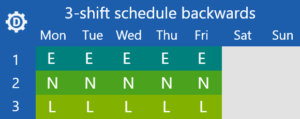
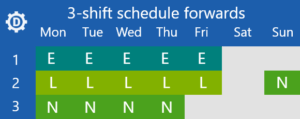
Rotating 2-shift schedule with permanent night shift team
There are also organisations that work with a 2-shift schedule and a permanent night-shift team. Sometimes, a permanent weekend-shift team is also added.
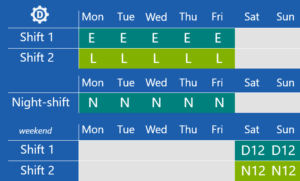
Allowance for 3-shift schedules
In most cases, employees working 3-shift schedules receive an allowance ranging from 15% – 20% for the entire shift.
4-shift schedule
Organisations where production must continue during the weekend, sometimes opt for a 4-shift schedule. In many cases, no work is scheduled on Sunday.
How does the 4-shift schedule work?
There are a number of versions of the 4-shift schedule. Examples include:
4-shift 2-2-2 schedule
The 4-shift 2-2-2 schedule means that an employee works two early, late or night shifts in rotation.
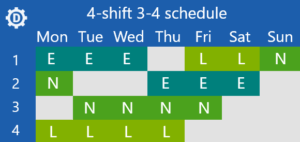
4-shift 3-4 schedule
The 4-shift 3-4 schedule means that an employee works series of either three or four shifts. In most cases, the series consist of the same types of shift.
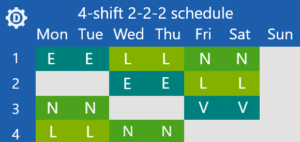
Allowance for 4-shift schedules
In most cases, employees working 4-shift schedules receive an allowance ranging from 23% – 27% for the entire shift.
5-shift schedule
Many organisations that need to be staffed 24/7 use a 5-shift schedule. On average, the number of working hours associated with this type of schedule is 33.6. Many employees like this system due to the short workweeks and high allowances. In some cases it is necessary to work in six or even seven shifts, in other cases several shift schedules are combined.
How does the 5-shift schedule work?
There are a number of versions of the 5-shift schedule. Examples include:
5-shift 2-2-2 schedule
The 2-2-2 schedule means that an employee works two early shifts, followed by two late shifts, followed by two night shifts, followed by four days off.
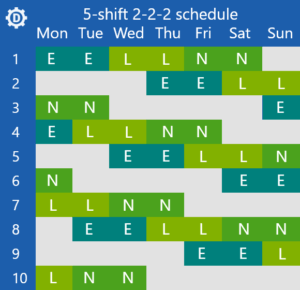
5-shift 3-2 schedule
The 3-2 schedule means that an employee works the same shift for three days in a row, followed by two days off.
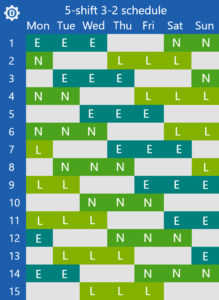
Allowance for 5-shift schedules
In most cases, employees working 5-shift schedules receive an allowance ranging from 28% – 33% for the entire shift.
Working Hours Act
When your employees will be working in shifts, it is important that you take the Working Hours Act into account. The following rules are of particular importance:
- Employees aged 18 and over are allowed to work a maximum of 12 hours per shift and a maximum of 60 hours a week.
- In case of a 3-shift schedule (including a night shift), an employee is allowed to work a maximum of 10 hours per night (between midnight and 6 a.m.).
- Over a 16-week period, an employee is allowed to work no more than an average of 48 hours.
- Employees working more than 16 night shifts over a period of 16 weeks are allowed to work no more than 40 hours a week.
- Over a 16-week period, an employee is allowed to work no more than 36 night shifts, unless mutually agreed otherwise.
Shift scheduling made easy with Dyflexis
If your employees will be working in shifts, creating a good schedule can be quite a challenge. Some of the handy built-in functionality in Dyflexis will make this as easy as possible for you.
Compliance with the Working Hours Act
Dyflexis has built-in controls that prevent you from assigning too many working hours to an employee. Thus, you will always be in compliance with the Working Hours Act.
Create standard schedules once for continued use
With Dyflexis, creating a staff planning doesn’t have to be time consuming:
- Create a standard schedule for each cycle week. It is possible to assign employees to each shift, but you can also create open shifts.
- On a weekly basis, select which standard schedule you wish to use. This also makes it easy to skip a week in case your organisation is closed.
- Do you wish to make any changes? No problem. This is useful when additional shifts are required in a particular week or when an employee is sick or on leave.
- When you select a schedule, the shifts of employees who are sick or on leave are automatically displayed as open shifts. This way you can see at a glance which shifts
still need to be filled.
Filling open shifts easily
If there are shifts that have not yet been assigned to anyone, you can send a push notification to your employees. They can then indicate if they are able to fill that open shift. Once they have done that, it is up to you to select the most suitable employee. By means of labels and requirements, you can ensure that only employees with the right skills and certificates will be able to respond to the open shift notification.
Quickly determine how much capacity is needed
During the planning process, a number of information streams are displayed at the top of each day. Examples include the expected turnover, the number of orders and the weather. By means of our API, you can also enter other important information such as the expected number of units to be produced. This makes it easy to quickly determine how much capacity is needed and adapt your staff planning accordingly.
Do you wish to learn more about Dyflexis and working in shifts? Request a demo and we will be happy to show you.






